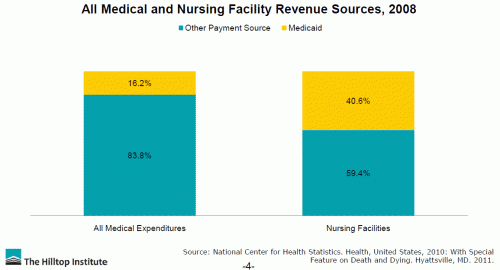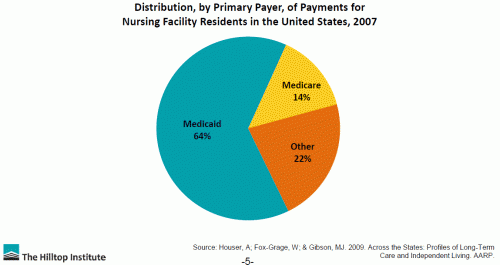My friend and colleague Peter Ubel thinks so, and he makes some good arguments. I think that he is partly correct. I believe we should consider federalizing the long term care portion of Medicaid, but would favor transitioning acute care Medicaid beneficiaries into private health insurance purchased in exchanges, with full premium support. My view is informed by a mixture of policy concerns and political realities as I understand them.
There is nothing fatally flawed about the structure of Medicaid with respect to providing access to acute care for beneficiaries. The latest study that has everyone buzzing about Medicaid (more: Austin | Pollack |Gardner) showing reduced access to specialists for Medicaid beneficiaries (children) could easily be reversed. Just raise the payment levels and make Medicaid the BEST payer instead of the worst (lower than private insurance and Medicare). That would fix the problem of reduced access for beneficiaries overnight. Of course, that will not happen.
Medicaid serving as the best payer seems far fetched, a fact that shows how disconnected from reality much of the Medicaid debate has become. Because in the the nursing home sector, Medicaid is, if not the best payer in terms of highest rate, the most predictable and predominant payer of such care. The ‘Medicaid debate’ we tend to have is is incomplete and misleading, because most of the ‘debate’ focuses on acute care Medicaid, and doesn’t even acknowledge that the most expensive part of the program is long term care, mainly nursing home care. The figure below, from a presentation by Charles Milligan and Cynthia Woodcock at the recent AcademyHealth meeting on Medicaid drives this reality home:
Medicaid pays for 16.2% of total health expenditures in the U.S., but 40.6% of the national NH expenditures. While Medicaid is considered a poor payer for acute care services (physician, hospital), it is viewed as a much better payer of nursing home care, as compared to other sources, primarily because there are fewer other sources. There is little private long term care insurance, and very few persons have enough savings to pay for even a few months in a nursing home, so Medicaid ends up paying a large chunk of the bill. If you are in the nursing home business, then unless you are a boutique provider, you are in the Medicaid business, as shown in another slide from Milligan and Woodcock (Note that Medicare only pays for up to 90 days in a skilled nursing facility if the stay is linked to an acute medical event). In total, Medicaid is the primary payer for two-thirds of persons living in a nursing home.
What should we do? To try and get a handle on what next for Medicaid, the first step is to realize that it is really three insurance programs (at least):
- Program 1: covers mainly pregnant women and children for acute services. There are around 45 Million such persons. The ACA would expand this portion of the the program greatly. This is the group that experienced barriers to access in the recent study, and this is where most of the debate is centered. Such beneficiaries are numerous, but are relatively inexpensive on a per capita basis.
- Program 2: covers long term care, most notably nursing home care for Medicare beneficiaries who are also poor and therefore covered by Medicaid. Such persons are know as Dual Eligibles, because they are covered by both Medicare and Medicaid). There are 9 Million duals, around two-thirds of them are eligible for Medicare because of age, the remainder due to permanent disability. This relatively small number of persons are extremely costly to both Medicare and Medicaid.
- Program 3: covers long term care and acute specialized services for persons younger than 65 who are disabled, but not eligible for Medicare; There are 5.9 Million such persons, who are more difficult to describe because of their variety of needs.
I suggest we move to transition Program 1, the largest group of Medicaid beneficiaries, into private insurance purchased in exchanges to be set up in the ACA. This will be more expensive than covering them in Medicaid, certainly initially. However, many conservatives seem to dislike Medicaid intensely because it is a government program, and many liberals are very worried about barriers to access for beneficiaries, which result from low payment rates and/or stigma associated with ‘poor people’s insurance’. Providers don’t like Medicaid because it doesn’t pay as much as private insurance or Medicare. If we are going to try exchanges and more persons buying their own insurance, lets try it. This approach would mainstream low income persons into the private insurance market, would expand (more than double) the potential of competition in the exchanges by adding more consumers to purchase insurance in these markets, and states could directly provide additional assistance navigating care that they decide low income persons needed. This approach assumes moving ahead with the general direction of the ACA.
I suggest we federalize the Medicaid cost of Program 2 noted above; this would primarily mean federalizing the nursing home costs of dual eligibles who are covered now by Medicare and Medicaid. There are numerous problems with the interaction between these two payers that cause problems for dual eligibles, that could best be addressed by having one payer responsible for their care. Two examples of policy reasons that could best be addressed by federalizing the Medicaid portion of dual eligibles.
- Bed hold payment. In some states, Medicaid pays for a bed to be ‘held’ for a beneficiary who goes to the hospital. In the case of dual eligibles, hospital care is paid for by Medicare. This creates an incentive for nursing homes to send patients to the hospital, thus shifting their care burden to the hospital and Medicare (and away from states), while still receiving bed hold payments and receiving the patient back after a hospitalization, often for reasons that could have been dealt with in the nursing home setting. Having one payer responsible for all the care of the now dual eligibles is that best way to sort this out.
- Reduced access to hospice benefits. Around 42% of non dual-eligible Medicare decedents received some hospice care prior to death. For dual eligibles (see pp.144-47), many of whom died in nursing homes, the figure is lower (36%), even though their need and potential to benefit from such services would be expected to be higher. The interaction of Medicare and Medicaid rules in some states impose a barrier to the receipt of hospice for dual eligibles. Medicare does not pay for room and board payments when someone receives hospice at a location that is not an inpatient hospice (most beneficiaries receive care at home, and Medicare doesn’t pay rent; if you are not in an inpatient hospice, you are expected to pay your own rent). In some states, if the Medicare hospice benefit is elected, then a patient may lose Medicaid’s payment for room and board, which is the majority of the charges for a stay in a nursing home. This would impose a tremendous cost on poor beneficiaries, that results in their not electing to use Medicare hospice benefits. These perverse rule interactions can reduce care options for very sick, elderly patients and could best be addressed if there was one payer responsible for the care of dual eligibles.
I am not sure what we should do for persons in Program 3, as they are a more complicated group to care for since they are younger than 65, but not eligible for Medicare. They suffer from a variety of physical, mental and intellectual disabilities, are among the most vulnerable members of society, and could need specialized services for years or decades. Medicaid could remain to care for such persons only, or other transitions may be more obvious to persons who know more about the needs of these populations than do I.
The bottom line is that Medicaid is really multiple programs, and this reality tends to be lost in most debates about the program. Most attention is focused on the more numerous (45 Million) low income persons covered for acute care services, missing the long term care aspect of Medicaid. I think we should move toward moving this large group of persons into purchasing private insurance in exchanges. The motivations for this suggestion are mostly political, as they could address key concerns of conservatives and liberals, and could aid in reaching some sort of consensus on how to move ahead in health reform by setting up insurance exchanges. Federalizing the Medicaid portion of the dual eligible’s care is more clearly indicated for a variety of policy and coordination of care issues; I gave only two brief examples, but there are more. I will blog on some of the other long term care realities that must be considered in any reform of the Medicaid program. And of course there will be difficulties and problems with any fix. However, these general directions seem the best course to take from my perspective.
Update: To clarify, three main points. First, the Medicaid debate needs to acknowledge the ‘three’ programs which it typically doesn’t. Second, federalizing Medicaid for dual eligibles is the best way I see to address some of the inefficiencies that lead to poor quality and higher cost among dual eligibles. Third, transitioning Medicaid into premium support so that low income persons would buy private insurance in exchanges would be a huge change that would face many practical issues that I haven’t addressed; in that sense, what I put forward is an idea or direction in which to move, and not a plan.



